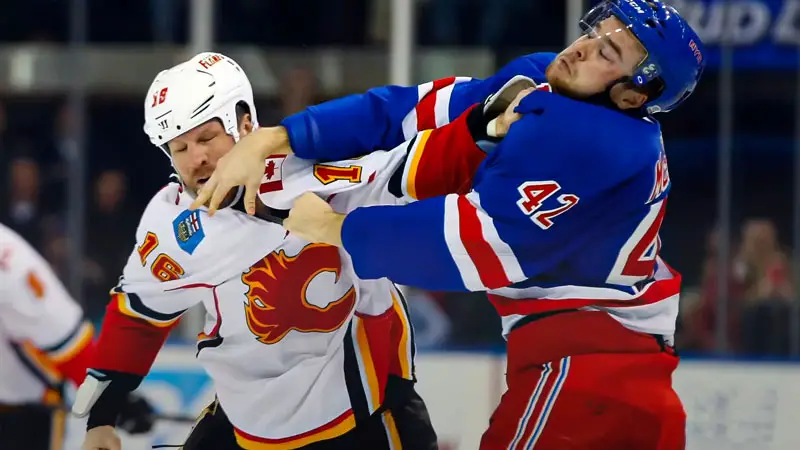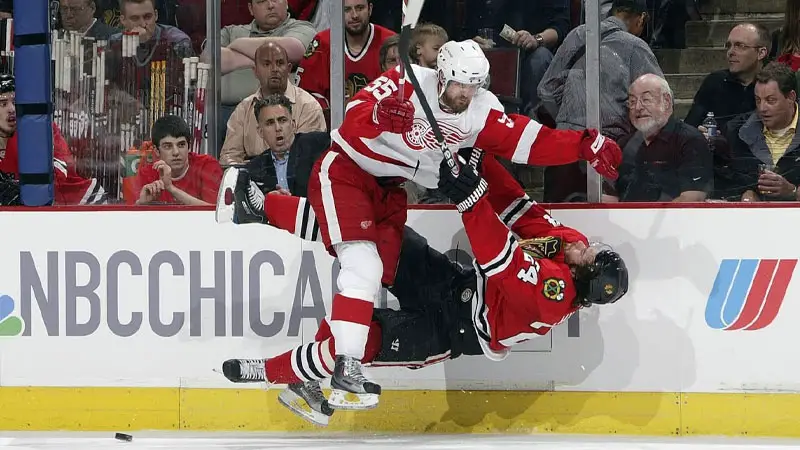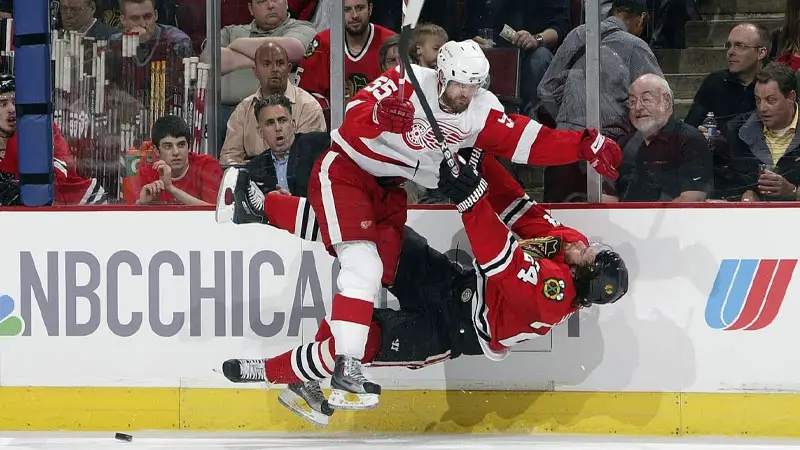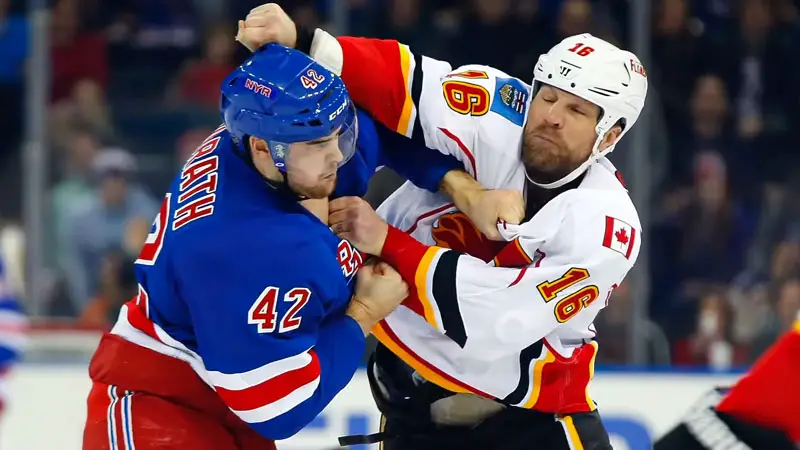Hockey, a sport celebrated for its speed, finesse, and physicality, often sparks curiosity about the seemingly paradoxical allowance of fighting on the ice.
“Why Is Fighting Allowed in Hockey?” delves into the historical fabric of this beloved game, where pucks and fists share the spotlight.
Beyond the formal rules, an unspoken code has woven fighting into the very culture of hockey, serving as a strategic tool, a form of emotional release, and a means to establish team identity.
This exploration navigates through the traditions, motivations, and evolving attitudes that have shaped the acceptance of fighting.
As we peel back the layers of this complex narrative, we uncover not only the historical roots but also the ongoing debates and shifts in the hockey landscape, offering insight into why fighting remains a distinctive and debated aspect of the sport.
Fighting in Hockey
Fighting has been a controversial and distinctive aspect of ice hockey for many years. While it’s not an official part of the game, fighting is not explicitly prohibited in the rules of the sport.
Here are some key points related to fighting in hockey:
Enforcement of Unwritten Rules
Fighting in hockey often occurs as a way to enforce unwritten rules and maintain a sense of accountability on the ice.
Players may engage in fights to protect teammates, respond to perceived injustices, or change the momentum of a game.
Penalties for Fighting
Players who engage in fights receive penalties for their actions, typically in the form of a five-minute major penalty for fighting.
In some cases, players may also receive additional penalties for instigating a fight or refusing to stop fighting when instructed by the officials.
Role of Enforcers
Some players are known as “enforcers” and are specifically valued for their physical play, including their willingness to fight.
Enforcers are often strategically used to intimidate opponents and protect skillful players.
Changing Attitudes
In recent years, there has been a shift in the attitudes toward fighting in hockey. Many argue that it leads to injuries and concussions and should be eliminated.
Leagues, including the NHL, have taken steps to discourage fighting through stricter penalties and a greater emphasis on skill and speed.
Fan Perspectives
Fan opinions on fighting in hockey vary. Some enjoy the physical aspect and see it as a traditional part of the game, while others advocate for its removal to promote player safety.
League Initiatives
The NHL and other leagues have implemented measures to reduce fighting, such as stricter penalties, fines, and suspensions for players involved in frequent fights.
Increased focus on player safety has led to a greater emphasis on skill development and a decrease in the prominence of enforcers.
International Differences
Attitudes toward fighting can vary between leagues and countries. For example, European leagues tend to have fewer fights compared to North American leagues.
It’s important to note that while fighting remains a part of the culture in some hockey leagues, there is an ongoing debate about its role in the sport, with a growing emphasis on promoting skill, speed, and player safety.
The future of fighting in hockey will likely continue to evolve based on changing attitudes and league initiatives.
Why Is Fighting Allowed in Hockey?

The allowance of fighting in hockey is a historical and cultural aspect of the sport.
While fighting is not explicitly written into the official rules of the game, it has been tolerated and, in some cases, accepted as part of the culture of ice hockey.
Several reasons contribute to the allowance of fighting in hockey:
Tradition and Culture
Fighting in hockey has a long tradition, dating back to the early days of the sport. Over time, it became ingrained in the culture of the game, with a perception that it adds excitement and intensity.
Player Policing
Hockey is a physical sport, and the allowance of fighting has been seen by some as a form of player policing.
Players may engage in fights to protect their teammates, deter opponents from taking liberties, or respond to perceived injustices on the ice.
Emotional Release
Hockey is a high-paced and emotional game, and fights can serve as a way for players to release built-up tension and frustration. It’s often viewed as a way for players to “settle scores” and move on with the game.
Entertainment Value
Some fans enjoy the spectacle of a hockey fight, viewing it as a part of the overall entertainment value of the sport. Fights can add drama and intensity to a game and generate excitement among spectators.
Team Dynamics
The presence of enforcers, or players known for their physical play and willingness to fight, has been a strategic element in team dynamics.
Enforcers may deter opponents from taking liberties with star players and contribute to team unity.
Unwritten Rules
Hockey has a set of unwritten rules that players often follow, and fighting can be a way of enforcing these rules. This includes responding to dangerous plays, hits, or actions perceived as disrespectful.
Maintaining Respect
Some argue that allowing fighting helps maintain a level of respect among players.
The idea is that if players know there is a consequence (a potential fight) for crossing certain boundaries, they may be less likely to engage in dangerous or unsportsmanlike behavior.
It’s important to note that while fighting is tolerated in some hockey leagues, there has been ongoing debate and discussion about its role in the sport.
In recent years, there has been a trend toward reducing fighting, with leagues implementing stricter penalties and emphasizing player safety.
The future of fighting in hockey may continue to evolve based on changing attitudes, cultural shifts, and the emphasis on player well-being.
Historical Perspective of Fighting in Hockey

The historical perspective of fighting in hockey can be traced back to the early days of the sport. While fighting was not a formal part of the rules, it became an accepted and sometimes expected aspect of the game.
Here’s a brief historical overview:
Early Days of Hockey
Hockey’s origins can be traced to the mid-19th century in Canada. In the early days, the sport was often played outdoors on frozen ponds and rivers. It was a physical game, and players didn’t wear the protective equipment used today.
Lack of Formal Rules
In the early years, hockey had minimal formal rules compared to today’s standards. As a result, players had more latitude in their actions on the ice.
Role of Enforcers
As the sport developed, certain players began to take on the role of enforcers. These players were known for their physical play, toughness, and willingness to engage in fights to protect teammates or shift the momentum of a game.
Broad Street Bullies Era (1970s)
The Philadelphia Flyers of the 1970s, known as the “Broad Street Bullies,” popularized a rough and physical style of play that included fighting.
The team’s success with this approach brought attention to the role of enforcers in the game.
Spectacle and Entertainment
Over time, fighting became not only a strategic element but also a spectacle that added entertainment value to the sport. Fans, particularly in North America, began to embrace the physical aspect of hockey, including fights.
Rule Changes
While fighting was never officially part of the rules, leagues introduced penalties for fighting, such as the five-minute major penalty, to address player conduct.
However, the penalties were not severe enough to eliminate fighting from the game.
Changing Attitudes
In the late 20th century and into the 21st century, there has been a shift in attitudes toward fighting in hockey.
Concerns about player safety, head injuries, and the overall image of the sport have led to increased scrutiny and debate over the role of fighting.
League Initiatives
In recent years, hockey leagues, including the NHL, have implemented measures to discourage fighting.
Stricter penalties, fines, and increased emphasis on skill and speed have been introduced to reduce the prevalence of fighting in the sport.
International Differences
Notably, European hockey leagues have generally had fewer fights compared to North American leagues. The cultural and historical context of the sport varies, influencing the acceptance and prevalence of fighting.
The historical perspective on fighting in hockey reflects the evolution of the sport and the changing attitudes toward physical play.
While fighting remains a part of the hockey culture in some contexts, ongoing efforts to prioritize player safety may continue to shape the future of the sport.
The Code of Conduct Regarding Fighting in Hockey

While there isn’t an official “code of conduct” specifically dedicated to fighting in hockey within the formal rulebook, there are unwritten rules and a longstanding code of conduct that has developed over the years.
This code is often referred to as “The Code” and is understood and followed by players, coaches, and fans.
Here are some key aspects of this unwritten code:
Mutual Consent
The majority of fights in hockey occur when both players involved willingly engage in an altercation. It is generally considered unacceptable to attack an opponent who is unwilling or unprepared to fight.
Respect for Opponents
Even in the heat of the moment, players are expected to have a level of respect for their opponents. This includes adhering to the mutual consent principle and avoiding actions that could lead to serious injury.
Protecting Teammates
One of the primary reasons for fighting in hockey is to protect teammates. If a player takes a cheap shot at a teammate or engages in dangerous play, it is often expected that another player will step in to address the situation.
Revenge and Retaliation
While retaliation is discouraged in many sports, in hockey, there is often an understanding that players may seek revenge for perceived injustices. This can include responding to a previous hit or play that was deemed inappropriate.
Setting the Tone
Fighting is sometimes seen as a way to set the tone for a game, particularly in physical and intense matchups. A well-timed fight can energize a team and its fans, providing a momentum shift.
Enforcers
Teams may have players known as “enforcers” who specialize in physical play and fighting. These players are often expected to defend teammates and deter opponents from taking liberties.
Acceptance of Penalties
Players engaging in a fight typically receive a five-minute major penalty for fighting. This acceptance of penalties is built into the culture of the sport, and players understand the consequences of their actions.
Officials’ Intervention
The unwritten code also recognizes the authority of the game officials. Players are expected to stop fighting when instructed by the referees, and failure to do so can result in additional penalties.
It’s important to note that while fighting has been a traditional and accepted part of the culture in many hockey leagues, there is an ongoing debate about its role in the sport.
In recent years, there has been a trend toward discouraging fighting, with leagues implementing stricter penalties and emphasizing player safety.
The unwritten code is subject to change based on evolving attitudes within the hockey community and the broader sports landscape.
Psychological Aspect of Fighting in Hockey
The psychological aspect of fighting in hockey involves examining the motivations, consequences, and impact on players’ mental states. Here are several psychological factors associated with fighting in hockey:
Emotional Release
Fighting can serve as a form of emotional release for players. The intense physicality and competitiveness of hockey can lead to heightened emotions, and a fight may offer a way for players to release built-up tension and frustration.
Team Unity and Identity
Fights can contribute to a sense of team unity and identity. When a player stands up for a teammate or engages in a fight to shift the momentum of a game, it can foster a strong bond among team members.
Intimidation and Deterrence
The presence of enforcers and the potential for fights can serve as a deterrent, intimidating opponents and influencing their behavior on the ice. The fear of facing a tough, physical team can impact the mental readiness of opponents.
Revenge and Retribution
Fights may be driven by a desire for revenge or retribution for perceived injustices on the ice. Players may feel a need to address a previous incident and regain a sense of justice through physical confrontation.
Momentum Shift
A well-timed fight can lead to a momentum shift in a game. Whether it’s to energize a team, fire up the crowd, or change the course of a match, the psychological impact of a fight can be significant.
Risk and Fear
Engaging in a fight involves an inherent risk, both physically and in terms of penalties. The fear of injury or the consequences of a fight can influence a player’s decision to engage or avoid physical altercations.
Coping with Pressure
The pressure of performing in a highly competitive and physical sport like hockey can be intense. Some players may use fighting as a coping mechanism, a way to assert control, or as an outlet for stress.
Fan Engagement
The reaction of the crowd to fights can have a psychological impact on players. The cheers or boos from the audience can influence players’ emotions and motivation.
Long-Term Psychological Effects
While the immediate psychological impact of a fight may vary, the long-term consequences, including potential injuries and the cumulative toll of physical play, can affect a player’s mental well-being over time.
Changing Attitudes
As attitudes toward fighting in hockey evolve, players may experience psychological shifts in how they view and approach physical play.
The increasing emphasis on skill and speed may alter the perceived importance of fighting in the game.
It’s essential to recognize that the psychological aspects of fighting in hockey can be complex, and individual players may respond differently to these dynamics.
As the sport continues to evolve, considerations for player safety and mental well-being are likely to play an increasing role in shaping the psychological landscape of hockey.
FAQs
How does fighting contribute to the game?
Fighting is believed to add excitement and intensity to hockey. It can serve as a strategic tool to change momentum, protect star players, and enforce a sense of accountability on the ice.
Some argue that it’s part of the sport’s culture, contributing to team dynamics and entertainment value.
Are there penalties for fighting in hockey?
Yes, players engaging in fights receive a five-minute major penalty. Additional penalties can be given for instigating a fight or refusing to stop when instructed by officials.
While penalties exist, the consequences may not be viewed as severe enough to eliminate fighting altogether from the game.
Do all hockey leagues allow fighting?
Attitudes toward fighting vary between leagues. While it is more accepted in North American leagues like the NHL, European leagues generally have fewer fights.
Cultural differences and evolving views on player safety influence the acceptance and prevalence of fighting in different hockey communities.
Is there a shift in the hockey community’s attitude toward fighting?
Yes, there’s been a notable shift in recent years. Concerns about player safety, head injuries, and changing perceptions of the sport have led to increased scrutiny.
Leagues are implementing stricter penalties, and fines, and emphasizing skill development, signaling a move away from the historical acceptance of fighting in hockey.
Wrapping Up
The allowance of fighting in hockey is deeply rooted in tradition, serving as a strategic and cultural element.
While historical acceptance has prevailed, a changing landscape emphasizes player safety and skill development. Ongoing debates and evolving attitudes within the hockey community are reshaping the role of fighting in the sport.
As leagues implement measures to discourage fighting, the future of hockey may see a continued shift toward emphasizing fair play, skill, and a heightened focus on the well-being of its athletes.








James Felix